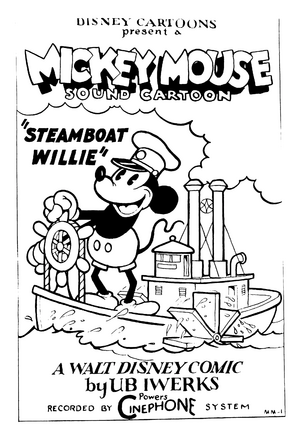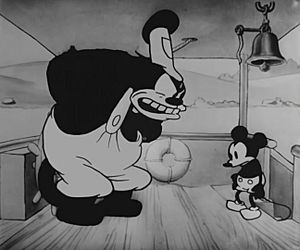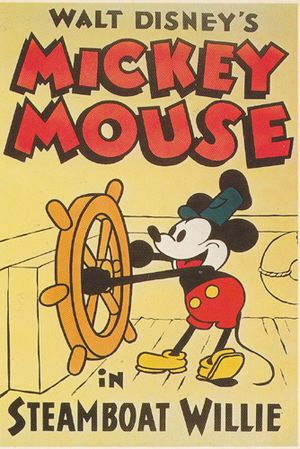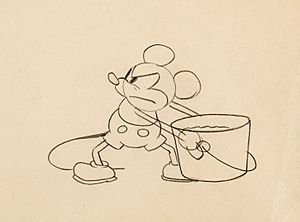Steamboat Willie facts for kids
Quick facts for kids Steamboat Willie |
|
|---|---|

The main poster of theaters
|
|
| Directed by | |
| Produced by |
|
| Story by |
|
| Starring | Walt Disney |
| Music by |
|
| Studio | Walt Disney Studio |
| Distributed by | Pat Powers (Celebrity Productions/Cinephone sound) |
| Release date(s) | November 18, 1928 (United States) |
| Running time | 7:47 |
| Country | United States |
| Language | English |
| Budget | $4,986.69 |
Steamboat Willie is a famous American animated short film from 1928. It was directed by Walt Disney and Ub Iwerks. This black and white cartoon was made by Walt Disney Studios. It was released by Pat Powers.
This cartoon is often seen as the first time Mickey and Minnie Mouse appeared. However, they were actually in a test showing of another cartoon, Plane Crazy, a few months earlier. Steamboat Willie was the third Mickey film made. But it was the first one to be shown to the public. Walt Disney wanted to make one of the first cartoons with fully synchronized sound. He was inspired after seeing the movie The Jazz Singer.
Steamboat Willie is special because it was one of the first cartoons with sound that matched the actions. It also had a full soundtrack added after the animation was done. This made it different from earlier sound cartoons. Walt Disney believed that sound was the future of movies. Steamboat Willie became the most popular cartoon of its time.
The music for Steamboat Willie was put together by Wilfred Jackson and Bert Lewis. It included songs like "Steamboat Bill" and "Turkey in the Straw". The film's title might even be a playful nod to the Buster Keaton movie Steamboat Bill, Jr.. Walt Disney did all the voices in the film. There isn't much talking, mostly sounds.
The film has been highly praised. It not only introduced one of the world's most loved cartoon characters. It also showed new ways to use technology in animation. In 1994, animators voted Steamboat Willie as the 13th greatest cartoon ever. In 1998, the United States Library of Congress chose it for the National Film Registry. This means it's considered very important. The cartoon became free for everyone to use in the United States on January 1, 2024.
Contents
Behind the Scenes: How it Started
Mickey Mouse was created to replace another character, Oswald the Lucky Rabbit. Disney's studio made Oswald, but another company, Universal Pictures, owned him. The first two Mickey Mouse films, Plane Crazy and The Gallopin' Gaucho, were silent. They couldn't find anyone to show them in theaters.
Walt Disney's brother, Roy O. Disney, said Walt was inspired by the movie The Jazz Singer (1927). This movie had sound. Walt thought adding sound would make cartoons much more exciting.
Even though Steamboat Willie is famous for its sound, it wasn't the very first cartoon with synchronized sound. Before it, Fleischer Studios made 19 sound cartoons called Song Car-Tunes. These were made between 1924 and 1926. But their sound didn't always match perfectly. Steamboat Willie used a special "click track" to help musicians stay on beat. This made the sound match the animation much better.
About a month before Steamboat Willie came out, another cartoon called Dinner Time was released with sound. But it wasn't very successful.
In 1927, a producer named Pat Powers created his own sound system called "Powers Cinephone." He convinced Disney to use Cinephone for Steamboat Willie. Their partnership lasted until 1930. Then, they had a disagreement about money. Powers even hired away Disney's main animator, Ub Iwerks.
What Happens in the Cartoon
At the start of the film, Mickey Mouse is steering a steam riverboat. He happily whistles a song and blows the boat's whistles. Soon, the captain, Pete, shows up. Pete tells Mickey to get off the bridge. Mickey playfully sticks out his tongue at Pete. Pete tries to kick Mickey, but Mickey moves. Pete ends up kicking himself! Mickey then falls down some stairs. He slips on a bar of soap and lands in a bucket of water. A parrot laughs at him, so Mickey throws the bucket on its head.
Pete takes over steering the steamboat. He chews tobacco and spits into the wind. The spit flies back and hits the boat's bell. Pete thinks this is funny and spits again. But this time, the spit hits him in the face, making him mad.
The steamboat stops at "Podunk Landing" to pick up animals. Mickey has trouble getting a skinny cow onto the boat. He fills the cow's stomach with hay to make it bigger. Just as they are leaving, Minnie Mouse runs to catch the boat. Mickey doesn't see her at first. She runs along the shore, calling his name. Mickey hears her and uses the cargo crane to lift her onto the boat by her bloomers.
When Minnie lands on the deck, she drops her ukulele and some music. A goat quickly eats them! Mickey tries to get the ukulele back from the goat. The goat gets dizzy from the struggle. Mickey and Minnie then use the goat's body like a phonograph. They play music by turning its tail like a crank. This makes them both laugh. Mickey then uses different things on the boat to make music. He pulls a cat's tail and stretches a goose's throat. He also tugs on baby pigs' tails. He even plays the mother pig's teats and uses a cow's teeth like a xylophone.
Captain Pete is not happy with their musical show. He makes Mickey peel potatoes as punishment. In the potato bin, the same parrot from before appears. It laughs at Mickey again. Mickey is annoyed and throws a potato at the bird. It knocks the parrot into the river. The film ends with Mickey laughing while sitting next to the potatoes.
What They Say
Mickey, Minnie, and Pete mostly act without talking. They make growls and squeaks. The only real talking in the film comes from the ship's parrot. When Mickey falls into the water, the bird says, "Hope you don't feel hurt, big boy! Ha ha ha ha ha!". At the end, the parrot repeats this. After it falls into the water, it yells, "Help! Help! Man overboard!".
Making the Cartoon

Steamboat Willie was made between July and September 1928. It cost about $4,986.69 to make, including copies for movie theaters. At first, some animators weren't sure if a sound cartoon would look real. So, before adding the final soundtrack, Disney showed the film to a test audience. Live sound was played along with the cartoon.
This test happened on July 29, when Steamboat Willie was only partly finished. The audience sat in a room next to Walt Disney's office. His brother, Roy, put the projector outside. The film was shown through a window. This way, the projector's noise wouldn't bother the live sound. Ub Iwerks set up a bedsheet behind the screen. Behind the sheet, he put a microphone connected to speakers for the audience.
The live sound was made behind the bedsheet. Wilfred Jackson played music on a mouth organ. Ub Iwerks banged on pots and pans for drum sounds. Johnny Cannon made sound effects with different tools. Walt Disney did the few sounds and laughs for the characters. After practicing, they were ready for the audience. This audience included Disney workers and their families.
The audience loved it! Their reaction gave Walt Disney the confidence to finish the film. He later said, "The effect on our little audience was nothing less than electric. They responded almost instinctively to this union of sound and motion. I thought they were kidding me. So they put me in the audience and ran the action again. It was terrible, but it was wonderful! And it was something new!"
Iwerks also said, "I've never been so thrilled in my life. Nothing since has ever equaled it."
Walt Disney went to New York City to find a company to make the sound system. He chose Pat Powers's Cinephone system. Powers had updated another sound system without giving credit to its creator.
The music for the final cartoon was played by the Green Brothers Novelty Band. Carl Edouarde led the band. Joe and Lew Green helped time the music to the film. The first try to record the sound with the film, on September 15, 1928, didn't work well. Disney had to sell his car to pay for a second recording. This time, it was a success! They even used a bouncing ball on screen to help keep the rhythm.
Steamboat Willie in Other Media
Steamboat Willie has appeared in many other places over the years.
Television and Film
- In 1992, an episode of The Simpsons called "Itchy & Scratchy: The Movie" showed a funny version of Steamboat Willie's opening. It was called Steamboat Itchy.
- The 1998 movie Saving Private Ryan, set in 1944, has a German prisoner nicknamed "Steamboat Willie." He talks about Mickey Mouse to try and get sympathy.
- The 2008 Futurama movie, The Beast with a Billion Backs, starts with a funny version of Steamboat Willie.
- In July 2023, Disney released a special called Steamboat Silly. It was part of their 100-year anniversary. It showed many copies of Mickey from this cartoon.
Video Games
- Levels based on Steamboat Willie are in games like Mickey Mania (1994), Kingdom Hearts II (2005), and Epic Mickey (2010).
- A special Steamboat Willie costume for Sora from Kingdom Hearts was in Super Smash Bros. Ultimate (2018).
- The Steamboat Willie versions of Mickey Mouse and Pete are characters you can race as in Disney Speedstorm (2023).
Other Uses by Disney
- In 1993, a shorter version of the cartoon's music was used in the background of Mickey's Toontown at Disneyland.
- Since 2007, a clip of Mickey whistling from Steamboat Willie has been used as the production logo for Walt Disney Animation Studios.
- In 2019, Lego released an official Steamboat Willie set. This was to celebrate Mickey Mouse's 90th birthday.
- The whistle sound from the film is used in the Mickey & Minnie's Runaway Railway ride. This ride opened at Disneyland in January 2023.
When and Where it Was Released
In Theaters
- July 1928 – First test showing with live sound.
- September 1928 – First try to record the sound with the film.
- November 1928 – The cartoon was first shown in theaters with its final sound.
- 1972 – The Mouse Factory, episode #33: "Tugboats" (TV).
- 1990s – Mickey's Mouse Tracks, episode #45 (TV).
- 1996 – Mickey's Greatest Hits.
- 1997 – Ink & Paint Club, episode #2 "Mickey Landmarks" (TV).
- Ongoing – Main Street Cinema at Disneyland.
Changes Over Time
In the 1950s, Disney removed a scene for television. In this part, Mickey played the mother pig like an accordion. This scene was later put back into the film. You can find the full version on the 1998 VHS The Spirit of Mickey. It's also on the Walt Disney Treasures DVD set "Mickey Mouse in Black and White" and on Disney+.
At Home
- 1984 – Cartoon Classics: Limited Gold Editions: Mickey (VHS).
- 1998 – The Spirit of Mickey (VHS).
- 2001 – The Hand Behind the Mouse: The Ub Iwerks Story (VHS).
- 2002 – Walt Disney Treasures: Mickey Mouse in Black and White.
- 2005 – Vintage Mickey (DVD).
- 2007 – Walt Disney Treasures: The Adventures of Oswald the Lucky Rabbit.
- 2009 – Snow White and the Seven Dwarfs (Blu-ray).
- 2018 – Celebrating Mickey 90th-anniversary collection (Blu-ray/DVD/Digital).
- Celebrating Mickey was reissued in 2021 as part of The Best of Mickey Collection. This was a special release for the U.S. Disney Movie Club. It also included Fantasia and Fantasia 2000 (Blu-ray/DVD/Digital).
- 2019 – Disney+ (streaming online).
- 2023 – Mickey & Minnie: 10 Classic Shorts – Volume 1 95th-anniversary collection (Blu-ray/DVD/Digital).
See also
- Mickey Mouse (film series)



